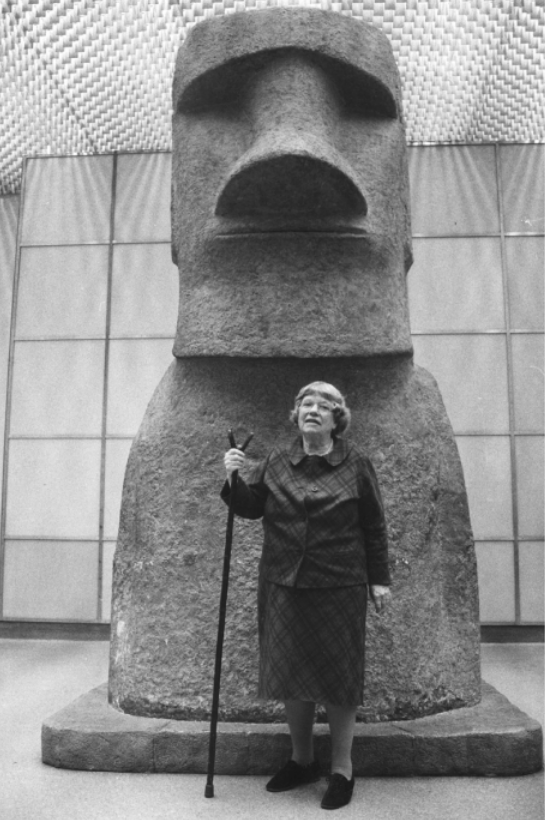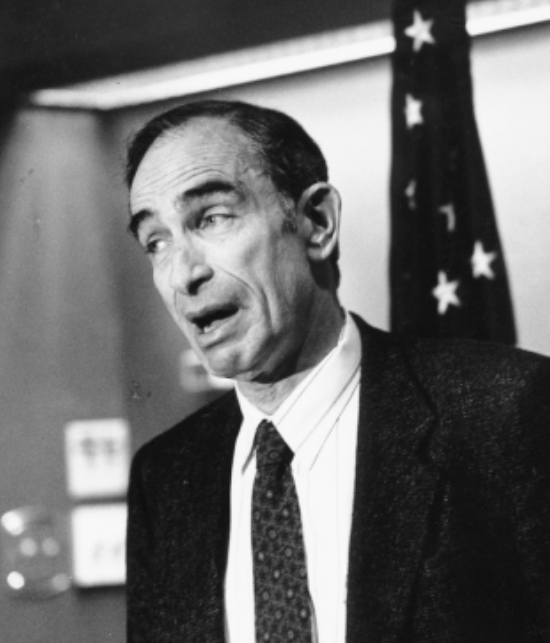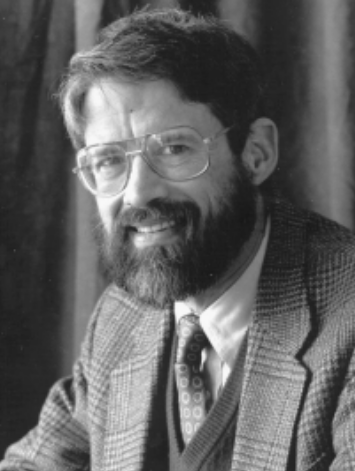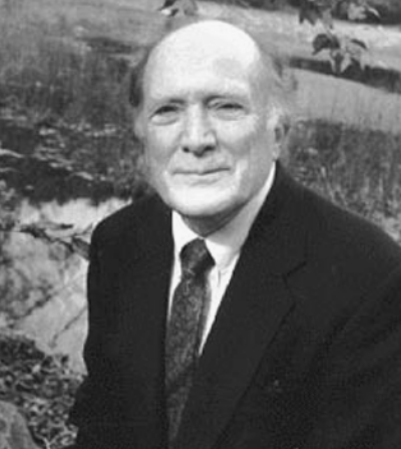
Fall 2007 | by Marjorie Mazel Hecht

Photo:Jack Manning/NY Times Pictures
“Global Warming” is, and always was, a policy for genocidal reduction of the world’s population. The preposterous claim that human-produced carbon dioxide will broil the Earth, melt the ice caps, and destroy human life, came out of a 1975 conference in Research Triangle Park, North Carolina, organized by the influential anthropologist Margaret Mead, president of the American Association for the Advancement of Science (AAAS), in 1974.
Mead—whose 1928 book on the sex life of South Pacific Islanders was later found to be a fraud—recruited like-minded anti-population hoaxsters to the cause: Sow enough fear of man-caused climate change to force global cutbacks in industrial activity and halt Third World development. Mead’s leading recruits at the 1975 conference were climate-scare artist Stephen Schneider, population-freak biologist George Woodwell, and the current AAAS president John Holdren—all three of them disciples of malthusian fanatic Paul Ehrlich, author of The Population Bomb.[1] Guided by luminaries like these, conference discussion focussed on the absurd choice of either feeding people or “saving the environment.”
 Photo: Stuart Lewis/EIRNS
Photo: Stuart Lewis/EIRNSMead began organizing for her conference, “The Atmosphere: Endangered and Endangering,” shortly after she had attended the United Nations Population Conference in Bucharest, Romania, in August 1974. She had already bullied American scientists with her malthusian view that people were imperiling the environment. She wrote in a 1974 Science magazine editorial that the Population Conference had settled this question:
At Bucharest it was affirmed that continuing, unrestricted worldwide population growth can negate any socioeconomic gains and fatally imperil the environment…. The earlier extreme views that social and economic justice alone can somehow offset population increase and that the mere provision of contraception can sufficiently reduce population—were defeated.[2]
The North Carolina conference, which took place Oct. 26-29, 1975, was co-sponsored by two agencies of the U.S. National Institutes of Health: the John E. Fogarty International Center for Advanced Study in the Health Sciences and the National Institute of Environmental Health Sciences. (Mead had been a Scholar in Residence at the Fogarty Center in 1973.)
It was at this government-sponsored conference, 32 years ago, that virtually every scare scenario in today’s climate hoax took root. Scientists were charged with coming up with the “science” to back up the scares, so that definitive action could be taken by policy-makers.
Global cooling—the coming of an ice age—had been in the headlines in the 1970s, but it could not easily be used to sell genocide by getting the citizens of industrial nations to cut back on consumption. Something more drastic and more personal was needed.
Eugenics and the Paradigm Shift
Mead’s population-control policy was firmly based in the post-Hitler eugenics movement, which took on the more palatable names of “conservation” and “environmentalism” in the post-World War II period. As Julian Huxley, the vice president of Britain’s Eugenics Society (1937-44), had announced in 1946, “even though it is quite true that radical eugenic policy will be for many years politically and psychologically impossible, it will be important for UNESCO to see that the eugenic problem is examined with the greatest care and that the public mind is informed of the issues at stake so that much that now is unthinkable may at least become thinkable.” Huxley was then director-general of the United Nations Educational, Scientific, and Cultural Organization (UNESCO).
By the 1970s, the paradigm shift that obliterated the optimistic development policies of Franklin Roosevelt and of Dwight Eisenhower’s “Atoms for Peace” program, was in full swing. The Club of Rome’s Limits to Growth, which removed the role of scientific advances, was drummed into the public consciousness. Nuclear energy, in particular, was under attack, because of its promise of virtually unlimited cheap energy to support a growing population. In the guise of protecting the world from potential terrorism, the Nuclear Non-Proliferation Treaty prohibited developing countries from acquiring civilian nuclear technologies.
In the United States, where nuclear plant construction was poised for takeoff, the dream of a nuclear-powered economy was under ferocious attack from the top down. The real “Dr. Strangelove,” RAND nuclear strategist Albert Wohlstetter, counseled U.S. Presidents on his strategy for winning a nuclear war, at the same time that he advocated an end to civilian nuclear energy. In one report after another, “experts” paid by the Ford Foundation, among others, argued that nuclear power was not economical, not safe, and just plain no good. Thus was scientific optimism ushered out.
The rock-sex-drugs counterculture of the ’68ers lapped it up. Man was seen as just another animal, but an exceedingly greedy one, using up Mother Nature’s resources and making a mess in the process. The unique cognitive ability of the human being, with its power to create new resources, to develop more advanced science and technology, and thus to provide better living standards was trashed.[3] Scientific pessimism invaded the scientific organizations.
Mead played a central role in this degeneration, from her obsession with spreading the “free love” message, to her participation in mind-control projects (the Cybernetics group at MIT) with her third husband, Gregory Bateson, intellectual author of the infamous MK-Ultra drug-brainwashing program.
The Endangered Atmosphere?
Mead’s keynote to the 1975 climate conference set the agenda: Mankind had advanced over the years to have international laws governing the sea and the land; now was the time for a “Law of the Atmosphere.” It was a naked solicitation of lying formulations to justify an end to human scientific and industrial progress.
Mead stated:
Unless the peoples of the world can begin to understand the immense and long-term consequences of what appear to be small immediate choices—to drill a well, open a road, build a large airplane, make a nuclear test, install a liquid fast breeder reactor, release chemicals which diffuse throughout the atmosphere, or discharge waste in concentrated amounts into the sea—the whole planet may become endangered….
At this conference we are proposing that, before there is a corresponding attempt to develop a “law of the air,” the scientific community advise the United Nations (and individual, powerful nation states or aggregations of weaker states) and attempt to arrive at some overview of what is presently known about hazards to the atmosphere from manmade interventions, and how scientific knowledge coupled with intelligent social action can protect the peoples of the world from dangerous and preventable interference with the atmosphere upon which all life depends….
What we need from scientists are estimates, presented with sufficient conservatism and plausibility but at the same time as free as possible from internal disagreements that can be exploited by political interests, that will allow us to start building a system of artificial but effective warnings, warnings which will parallel the instincts of animals who flee before the hurricane, pile up a larger store of nuts before a severe winter, or of caterpillars who respond to impending climatic changes by growing thicker coats [sic].
Mead deplored the fact that some scientists might be so cautious to “protect their reputations” that they would not act. She described this as the “modern equivalent of fiddling while Rome burns.” As for the thinking population, she deplored “those who react against prophets of doom, believing that there is not adequate scientific basis for their melanchology prophecies, [for they] tend to become in turn prophets of paradisiacal impossiblities, guaranteed utopias of technological bliss, or benign interventions on behalf of mankind that are none the less irrational just because they are couched as ‘rational.’ They express a kind of faith in the built-in human instinct for survival, or a faith in some magical technological panacea.”
What Scientists Need To ‘Invent’
Here’s what Mead wanted the atmospheric scientists to do:
What we need to invent—as responsible scientists—are ways in which farsightedness can become a habit of the citizenry of the diverse peoples of this planet. This, of course, poses a set of technical problems for social scientists, but they are helpless without a highly articulate and responsible expression of position on the part of natural scientists. Only if natural scientists can develop ways of making their statements on the present state of danger credible to each other can we hope to make them credible (and understandable) to social scientists, politicians, and the citizenry.
…I have asked a group of atmospheric specialists to meet here to consider how the very real threats to humankind and life on this planet can be stated with crediblity and persuasiveness before the present society of nations begins to enact laws of the air, or plan for ‘international environmental impact statements.’ “
Throughout her presentation, Mead stressed the need for consensus, an end-product free from any troubling “internal scientific controversies” that might “blur the need for action.”
Mead and her co-organizer William W. Kellogg (a climate scientist from RAND and later NCAR, the National Center for Atmospheric Research), edited a report on the proceedings of the conference into a little book published a year later.[4] (The Mead-Kellogg team also came up, in 1976, with the idea that carbon dioxide emissions should be controlled “by assigning polluting rights to each nation”[5]—an early version of the cap-and-trade program of Al Gore.)
The conference proceedings identify the presenters and the rapporteurs for the sessions, but there is no list of all the participants. Some discord is reported in the audience (more than is “allowed” today in climate change circles!), and Margaret Mead steps in to push for “consensus.” The editors note in their initial comment on the proceedings, “… we believe that we have captured something very close to consensus.”
Mead’s Propagandist Scientists

Stephen Schneider

John Holdren

George Woodwell
Three of Mead’s scientists who have preached global warming and population control since the 1975 conference. All have worked closely with Paul Ehrlich, who thinks the the U.S. population should be cut in half (not starting with hisfamily and friends, of course).
A few of the 1975 conference presenters stand out today as leading spokesmen for global warming:
Climate scientist Stephen Schneider, who was promoting the global cooling scare scenario in the 1970s, made himself notorious by telling Discover magazine in 1989: “To capture the public imagination, we have to offer up some scary scenarios, make simplified dramatic statements and little mention of any doubts one might have. Each of us has to decide the right balance between being effective, and being honest.”[6]
Schneider has been one of the most visible and voluble scientist-lobbyists for global warming, testifying to Congress, playing a prominent role in the Interngovernmental Panel on Climate Change (IPCC), and setting the standards by which it presents its opinions to the public without any hint of uncertainty. At Stanford University he has trained new generations of climate scare clones. He is also a close friend of The Population Bomb’s Paul Ehrlich and wife, Anne Ehrlich, both at Stanford, whose anti-population philosophy he fully shares. He and Paul Ehrlich co-authored articles on the “limited carrying capacity” of the Earth, and challenged population advocate Julian Simon with a bet on how fast man would exhaust certain resources.
John Holdren, another Ehrlich collaborator at Stanford, is now a Harvard-based energy specialist, and the president of the AAAS. Holdren has co-authored several articles and books with Paul Ehrlich, elaborating on their formula (I = PAT) that the impact of an increase in population and consumption (affluence), although modified by technology, is degrading the environment. Therefore, population growth should stop. Their underlying assumption, like Mead’s, was that technology cannot solve the problems created by “limitless” population growth. (Ehrlich’s view, in fact, is that the United States can sustain only 150 million people; there are now 302 million of us.)
In December 2006, Holdren shepherded a radical global warming resolution through the AAAS board of directors, which was announced at the organization’s annual meeting in February 2007, the first ever of such resolutions.[7] Its conclusions, the AAAS stated, “reflect the scientific consensus represented by, for example, the Intergovernmental Panel on Climate Change….”
Holdren is one of a small group of anti-nuclear “nuclear experts” who push technological apartheid—the doctrine that poorer nations cannot be allowed to gain knowledge of nuclear science.
Dr. George Woodwell, a member of the National Academy of Sciences and a Fellow of the Academy of Arts and Sciences, is a global warming fanatic whose stated beliefs indicate that he abhors human beings in general, and whose zealousness in this cause leads him to bend the truth. Woodwell works closely with John Holdren at the Woods Hole Research Center, which Woodwell founded and of which Holden is a director.
To get the flavor of Woodwell’s views: In a 1996 interview, he proclaimed: “We had an empty world that substantially ran itself as a biophysical system, and now that we have filled it up with people, and the sum of human endeavors which is large enough to affect global systems, it no longer works properly.”[8] He attributes climatic changes and warming to “the crowding of people into virtually every corner of the Earth.” “How will his plan for a 50 percent cut in [carbon dioxide] emissions happen?” the interviewer asks. Woodwell says it will require “a concerted effort on the part of the scientific and scholarly community; the public will have to be sufficiently enraged….” He stresses that the scientific community is going to have to exert pressure on the government to act.
Woodwell’s 1989 article on global warming in Scientific American was illustrated with a drawing that showed seawater lapping at the steps of the White House.
Another example of his “bending” the truth: During the environmentalist campaign against DDT, Woodwell wrote a technical article for Science magazine in 1967 purporting to show that there were 13 pounds of DDT per acre of soil. He neglected to mention, however, that he measured the soil at the spot where the DDT spray trucks washed down! This detail came out in the official EPA hearings on DDT in 1972, but neither Woodwell nor Science magazine issued a retraction.[9]

Dr. James Lovelock is best known as the inventor (in the 1970s) of the Gaia thesis, which views the Earth as a whole as a living biological being. Lovelock’s worry about global warming has led him to make dire predictions about what will happen: “Before this century is over, billions of us will die, and the few breeding pairs of people that survive will be in the Arctic where the climate remains tolerable,” according to one of his scenarios.[10]
But unlike the three other scientists above, who attended the 1975 Mead conference, Lovelock has called for nuclear power to slow the disaster that he warns is coming. Again, unlike the three others, Lovelock sees mankind as a “resource” for the planet, its “heart and mind.”
During the 1975 Mead conference, Lovelock occasionally pooh-poohed some of the more hysterical suggested disasters of man-made warming. In a discussion on ozone depletion, for example, Lovelock strongly criticized the National Academy of Sciences report of the coming danger of skin cancers from increased ultraviolet radiation. “To speak of ultraviolet radiation as analogous to nuclear radiation is most misleading,” he said.
(During this discussion, the report of the proceedings says, Mead called for a ” ‘ceasefire’ in an attempt to avoid a premature polarization of the participants.” Referring to the uncertainty of potential effects, she stated, “The time interval required before we begin to see clear evidence of a particular manmade effect on the enviromment may be long compared to the time in which society has to act…. A decision by policy-makers not to act in the absence of scientific information or expertise is itself a policy decision, and for scientists there is no possibility for inaction, except to stop being scientists.”)
‘Anticipating’ Global Warming
Mead’s co-editor of the proceedings, climatologist William Kellogg, notes that “the main purpose of this conference is to anticipate the call that will be made on scientists and leaders of government regarding the need to protect the atmospheric environment before these calls are made.”
Kellogg outlines the difficulties of computer modelling of climate change and man’s role because of the nonlinearities involved in climate, but he concludes that climate models “are really the only tools we have to determine such things.” He then states,
The important point to bear in mind is that mankind surely has already affected the climate of vast regions, and quite possibly of the entire earth, and that its ever escalating population and demand for energy and food will produce larger changes in the years ahead.
Kellogg reviews the potential global warming disaster scenarios, which are actually what then became the scientific research agenda for the next 30 years. He himself had put forward arguments that the release of the energy necessary to support a “large, affluent world population could possibly warm up the earth excessively.”
The issues Kellogg laid out are all too familiar today: warming that will melt “the Arctic Ocean ice pack and the ice sheets of Greenland and the Antarctic.” “What will happen to the mean sea level and the coastal cities around the world?” Kellogg asks.
Increased carbon dioxide was high on the list of man-related climate change disasters. It was admitted that there might be other factors involved, but,
It is concluded that, in cases where the societal risk is great, one should therefore act as if the unaccounted-for effects had been included, since we have no way of dismissing the very possibility that the calculated effect will prevail.
In the Conference summary of recommendations, Kellogg’s thrust is repeated: Scientists and policy-makers must act now on man-caused climate change. “To ignore the possibility of such changes is, in effect, a decision not to act.”
John Holdren repeated this idea: “How close are we to the danger point?” of ecological collapse, he asked. But then he went on to say that it doesn’t matter, because we need to act now. He stated:
We already have reached the scale of human intervention that rivals the scale of natural processes…. Furthermore, many of these forms of intervention will lead to observable adverse effects only after time lags, measured in years, decades, or even centuries. By the time the character of the damage is obvious, remedial action will be difficult or impossible. Some kinds of adverse effects may be practically irreversible….
Should We Feed People?
One of the most telling discussions concerned the view of man as just another species competing for resources. The report of the summary session of the first day of the conference stated “that we as a species are trying to maintain ourselves at the expense of other species; there seems to be a conflict between preserving nature and feeding the rapidly increasing population. Is our major objective really to feed the population, or do we realize we cannot continue to feed the world at any price? Where do we strike a balance between preserving nature and feeding the world?”
Stephen Schneider’s presentation, “Climatic Variability and Its Impact on Food Production,” sounds the alarm:
There is a further fear that mankind’s industrial and energy production activities may affect the climate and lead to enhanced probabilities of extreme vaiability. Thus the food-climate crisis could be very near-term and of major significance…. The smallest impact, and one we have already seen, is the triggering of higher prices for food by crop failures in one nation, such as the USSR in 1972, which had to be made up by North America…. Simultaneous crop failures in North America and the USSR could lead to even higher prices and widespread starvation throughout the world. Some estimates predict that upwards of 100 million people in developing countries could starve, while the more affluent countries would be just inconvenienced by a significant crop failure in North America.
As a gauge of the immorality of the conference participants, Schneider felt compelled to assert that “national energy and food policies must start with the assumption that population control by mass starvation or nuclear war is untenable”!
Like the other presenters at the conference, and the global warming faction today, Schneider fails to see how curbs on science and industry will kill people by preventing the economic development that permits a higher relative potential population density. Advances in science and technology are mentioned, but usually in the context of better energy savers and conservation, not in allowing more people to be supported at a better standard of living on a given amount of land.
Woodwell’s presentation, “The Impact of Enviromental Change on Human Ecology,” is even more alarmist. He writes:
A careful analysis of the extent to which the earth’s net primary production is being used directly in support of man leads to the conclusion that, at present, as much as 50 percent of the net production is being used in support of human food supplies…. The fact that the toxic effects of human activities are spreading worldwide and reducing the structure of the biota is an indication that human activities at present exceed the capacity of the biosphere for repairing itself.
The Noösphere to the Rescue
Thirty-two years after this 1975 conference, the world’s population, its science and technology, and its industry are dangerously in the grasp of Margaret Mead’s minions, including those on the IPCC. A good part of the population is scared, as planned, by the potential effects of human-caused global warming. They are ready to react, as Mead demanded, to “warnings which will parallel the instincts of animals who flee before the hurricane,” and in the process tear down the very institutions and technologies that can obviate the perceived “limits to growth.”
In the intervening 32 years, most of our scientific institutions have been taken over by an anti-science ideology, typified by the views of a Stephen Schneider or a John Holdren. How can there be a science when the mind and its capacity for creativity is denied, when man is put equal to beast, and when man’s advancements are perceived as ruining the pristine confines of a limited world? Such pessimism is a formula for a “no future” world.
The question remains, will the reservoir of sanity, in particular in today’s youth, who did not live through the greenwashing of the 1970s and 1980s, be able to force reality—climate reality and financial reality—on the rest of the population? Will the Noösphere, man’s creative ability to change the Biosphere, prevail?
Notes
[1] The Population Bomb, published in 1968, was a campus bestseller among the 1968er generation. Ehrlich employs the repeatedly discredited argument of the British East India Company’s Parson Thomas Malthus (1766-1834) that population increases geometrically while food supply increases only arithmetically. Malthus was proved wrong in his own lifetime by the development of fertilizers and scientific farming, and repeatedly thereafter by the application of successive advances in mechanization, chemistry, and biochemistry to agriculture.
Describing the spirit of “gloom and misanthropy” into which the English population had fallen following the dashing of their hopes for progress in the French Revolution, Malthus’s opponent Percy Bysshe Shelley wrote: “Inquiries into moral and political science, have become little else than vain attempts to revive exploded superstitions, or sophisms like those of Mr. Malthus.” (Author’s introduction to “The Revolt of Islam,” 1818.)
[2] Margaret Mead, “World Population: World Responsibility,” Science, Sept. 27, 1974 (editorial), Vol. 185, No. 4157. The only opposition to the Rockefeller/Club of Rome policy presented at the Bucharest conference came from Helga Zepp-LaRouche.
[3] See, for example, “The New Environmentalist Eugenics,” by Rob Ainsworth, EIR, March 30, 2007.
[4] The Atmosphere: Endangered and Endangering, Margaret Mead, Ph.D. and William W. Kellogg, Ph.D., eds. Fogarty International Center Proceedings No. 39, 1976 (Washington, D.C.: U.S. Government Printing Office, DHEW Publication No. [NIH] 77-1065).
[5] Cited in P.C. Sinha, Atmospheric Pollution and Climate Change (Anmol Publications PVT, 1998).
[6] Schneider made this statement in an interview with Discover magagzine, October 1989.
[7] The text of the shamefully unscientific AAAS resolution, which closely follows Mead’s 1975 prescription, reads in part: “The scientific evidence is clear: global climate change caused by human activities is occurring now, and it is a growing threat to society. Accumulating data from across the globe reveal a wide array of effects: rapidly melting glaciers, destabilization of major ice sheets, increases in extreme weather, rising sea level, shifts in species ranges, and more. The pace of change and the evidence of harm have increased markedly over the last five years. The time to control greenhouse gas emissions is now.
“The atmospheric concentration of carbon dioxide, a critical greenhouse gas, is higher than it has been for at least 650,000 years. The average temperature of the Earth is heading for levels not experienced for millions of years…. As expected, intensification of droughts, heat waves, floods, wildfires, and severe storms is occurring, with a mounting toll on vulnerable ecosystems and societies. These events are early warning signs of even more devastating damage to come, some of which will be irreversible.
“Delaying action to address climate change will increase the environmental and societal consequences as well as the costs…. Developing clean energy technologies will provide economic opportunities and ensure future energy supplies.
“The growing torrent of information presents a clear message: we are already experiencing global climate change. It is time to muster the political will for concerted action. Stronger leadership at all levels is needed. The time is now. We must rise to the challenge. We owe this to future generations.”
[8] www.annonline.com/interviews/961217/
[9] Woodwell’s original article is “DDT Residues in an East Coast Estuary: A Case of Biological Concentration of a Persistent Insecticide,” Science, May 12, 1967, pp. 821-824. His admission that there was only 1 pound of DDT found per acre appears in the transcript of the EPA’s 1972 hearings on DDT, p. 7,232. He also managed to measure DDT in the forests at a site near an airstrip where crop-dusting airplanes tested and calibrated their DDT spraying equipment.
[10] Woodwell’s commentary in the Independent, Jan. 16, 2006, summarizes his views.


